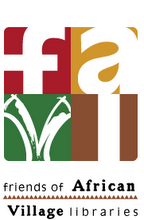FAVL will supplement its standard library model in five specific ways:
1. Provide a larger number of books oriented toward girls (featuring girls as central characters and/or written by female authors) and have them displayed in a special “corner” area with girl-oriented mural designs. Currently FAVL provides a generous selection of children’s books and novels for young adults that are available in bookstores in Ouagadougou. Most reading material is in French, the language of instruction, and there is limited reading material available in Dioula, the “national language” spoken in much of southwestern Burkina Faso. There are titles available that features themes for young and adolescent girls; the recent bande dessinee (BD) Aya, by Marguerite Abouet, comes to mind. FAVL would purchase 40 such books for each library, build a special display bookcase using local carpenters, paint a corner of the library with appropriate murals, provide the corner with a large woven mat (made locally) and cushions (made locally).
2. Publish twenty-five copies of four micro-books oriented around the activities of girls in the village of Dimikuy and Boni. In Spring 2008, FAVL piloted a new model for volunteer activities in the libraries of Burkina Faso involving the creation of micro-books for children in French and national languages. Our pilot project was carried out with funding from the Santa Clara Rotary Club. Chelsea Rangel, a student at the University of Montana. Chelsea worked with village librarians, teachers, and students to conceive of and take photographs for three children’s books in French and Dioula. FAVL volunteers did the graphic design and layout. The books were printed in San Jose in a small print run of 100 copies each. The books were distributed to FAVL libraries and other educational entities in southwestern Burkina Faso. With funding from the new Field Foundation, FAVL volunteers who will be in Burkina Faso in summer 2009 would produce and publish four books with themes related to girls and women, and print 25 copies of each for distribution to FAVL libraries. If there is further demand for the books, a larger print run can be made.
3. Firmly establish a variety of reading programs for children by staffing for one year two female “reading coaches” in each library who will work during after-school hours and who will promote and conduct outreach activities in the villages. Currently, FAVL only has funding for one librarian for each village library. Village librarians are typically women who have completed some secondary schooling and have remained in the village. They often have very little experience with reading programs, and have limited time to sustain reading programs that are initiated by volunteers who spend time in the libraries. Greater funding would permit each library to hire two reading coaches who would spend 2-3 hours per day helping younger children read, by giving one-on-one reading help and by holding story hours and other fun activities for primary school students. Female reading coaches would serve as positive role models for girls in these rural villages, who in many cases withdraw early from primary and secondary school in order to marry and work in agriculture.
4. Build two latrines (one for girls and one for boys) for use by library patrons. A variety of sources (for example, http://www.nytimes.com/2005/12/23/international/africa/23ethiopia.html?pagewanted=all) suggest that providing separate latrine facilities is an important practical and symbolic step towards ensuring that educational facilities are “girl friendly.” FAVL would build two latrines for each library, designating one as the girl’s and other as the boy’s latrines. This would be very unusual for Burkina Faso villages, and will be sure to generate interesting discussions regarding “equal treatment” of the genders.
5. Build “reading circles” for use by girls and boys to read outside and play children’s games. Children reading in libraries very often want to enjoy their books outside of the building, whose interior can often reach uncomfortable temperatures (buildings are made of mud bricks and roofs are tin). FAVL has tried to build a “reading circle” outside of every library, involving a circular bench shaded by a traditional straw shelter (a “summer hat” as they are known in Ghana, or a “hangar” as they are known in Burkina Faso. These areas are quickly dominated by children, since the libraries typically stock large games in these areas (mankala, for example). These games are played by both girls and boys. Our current funding level for the new libraries is limited, and with the grant from New Field Foundation we would be able to build two reading circles for the outside of each library. Note that these reading circles are often sites where community members hold meetings outside of library hours.

2 comments:
Thanks! "Drop in" anytime...
MK
Very cool! Kofi Anan has several quotes on the importance of the education of girls in a country's development that would be great to include in the mural. You might also like to publicize the new Baobab prizes that were begun by two African women. Hooray and well done!
Post a Comment